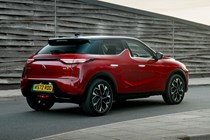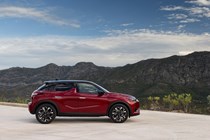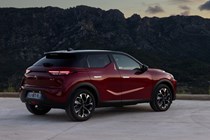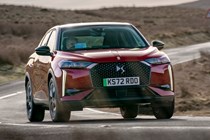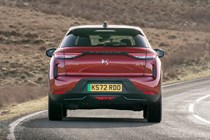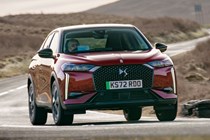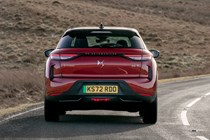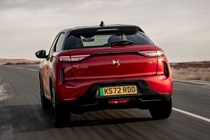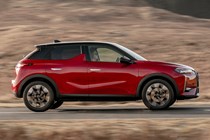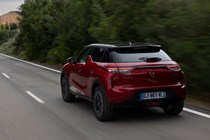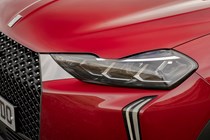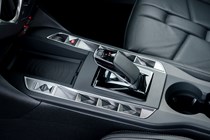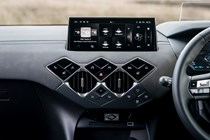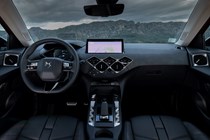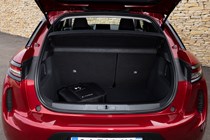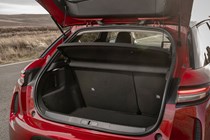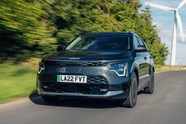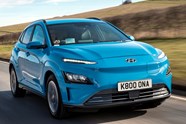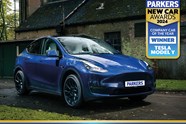
DS 3 E-Tense review
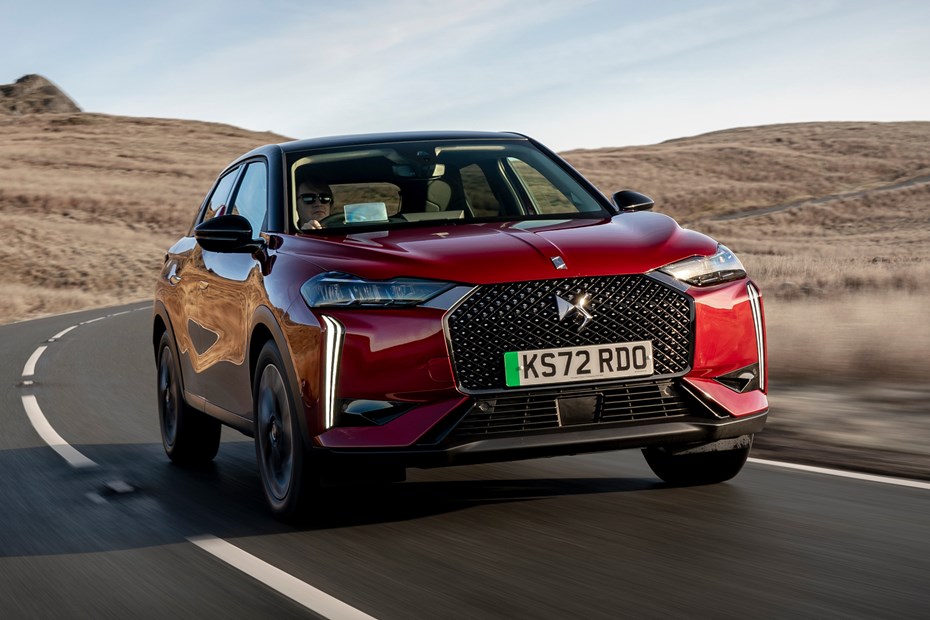
At a glance
| Price new | £37,265 - £42,035 |
|---|---|
| Used prices | £12,374 - £18,537 |
| Road tax cost | £0 |
| Insurance group | 28 - 30 |
Get an insurance quote with

|
|
| Fuel economy | 3.8 - 4.4 miles/kWh |
| Range | 232 - 270 miles |
| Miles per pound | 6.0 - 12.9 |
| View full specs for a specific version | |
Available fuel types
Fully electric
Pros & cons
- Well-equipped
- Rapid charging
- Chic styling
- Expensive for what it is
- Cramped rear seats
- Small boot
DS 3 E-Tense SUV rivals
Overview
The small premium SUV market is booming right now, but the electric niche within it remains largely untapped. The DS 3 E-Tense almost has the market to itself, with the biggest competition coming from the Kia Niro EV and Hyundai Kona, both of which are larger and a little less upmarket. The BMW iX1 is suitably premium, but it’s much more expensive.
The DS 3 (formerly known as the DS 3 Crossback) was facelifted in January 2023 – and it received some well-aimed changes to its exterior styling, infotainment technology and powertrains. The E-Tense benefited the most, as it gained a larger 54kWh battery pack and a more powerful electric motor, which saw its maximum range climb from around 200 miles to 250 miles.
DS hopes that its smallest premium SUV’s catwalk-ready looks, upmarket interior, extended range and price-tag that undercuts cars like the Mercedes EQA and Volvo XC40 Recharge will be enough to coax buyers towards its showrooms. Even if the 3 is smaller.
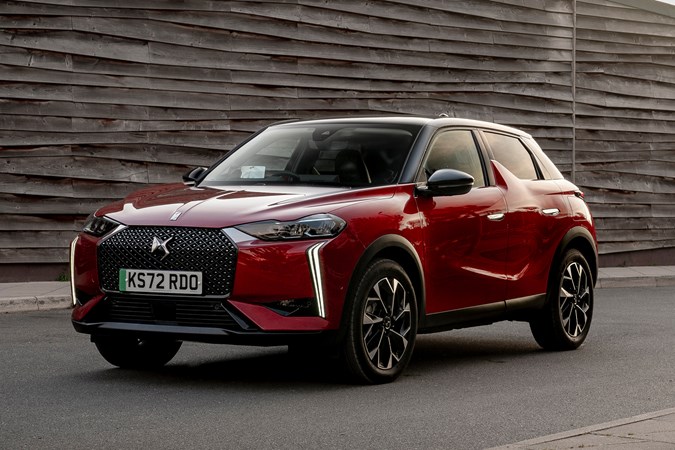
We’re not so sure, though. Under the skin, the DS 3 E-Tense is based on the same underpinnings as the Peugeot e-2008 and Vauxhall Mokka Electric which, at the time of writing, were both around £1,000 cheaper. They’re arguably better cars, too, with more logical cabins and superior practicality.
The DS’s trump card over its Stellantis siblings is that it now has a larger battery, which means it can drive further. But the Peugeot and the Vauxhall will get the same upgrade when they’re facelifted later this year. If the price difference doesn’t change between the cars, that might be enough to stop the DS in its tracks. Scroll down to see what we make of the DS 3 E-Tense and to learn how it compares to its rivals.
What’s it like inside?
Modern and trying quite hard to be chic. Like a French wine bar in a slightly dodgy bit of London. There are plenty of quirky features, like the diamond-shaped switch panels on the dashboard, unusually placed window switches on the centre console and funky ‘watchstrap’ leather upholstery.
Most of the items within your wingspan feel high quality, too. The dashboard and steering wheel are trimmed in soft-touch materials and all the switchgear is solid. The layout, though, is one that we find confusing, unintuitive, and ugly. The switches are peppered across the dash with little thought to where they’d be most useful, and fans of symmetry had best look away as this design sees nothing line up as you feel it should.
There are some good points – take the infotainment system. It’s a crisp 10.3-inch unit with clever tech like over-the-air updates and standard support for Apple CarPlay and Android Auto. It’s also responsive and easy to navigate, which is good because that’s where the heating controls are. We’d prefer to see physical buttons for such important controls, but at least you get shortcut buttons to jump to the correct sub menu.
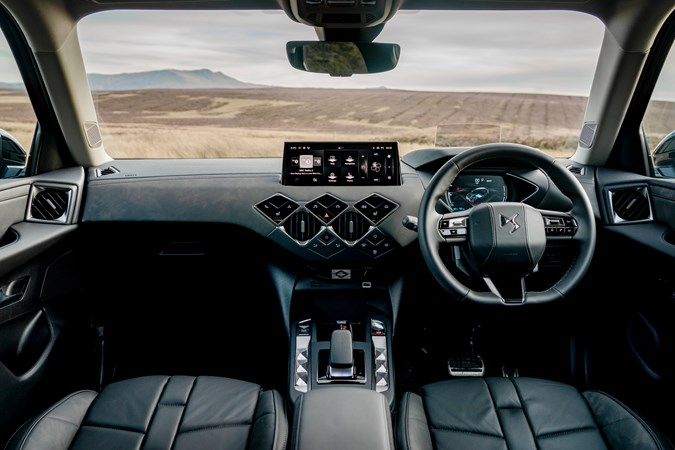
There’s a big problem with the infotainment system, though – it’s been mounted facing the wrong way! It’s angled to face the driver in left-hand drive markets, but DS didn’t bother rotating it to face the driver in the UK. That would have meant creating another mould for the dashboard top – and that’s money the company obviously couldn’t justify spending.
Keep digging and you’ll find more areas where DS has shaved costs. The glovebox, for example, is tiny because it needs to dodge some electrical components under the dash that aren’t a problem for left-hand drive cars, but which DS didn’t want to move for UK buyers. There’s also hardly any storage space and the centre console flexes when you rest your knee on it.
Visibility isn’t great, either. That shark fin B-pillar looks great, but it eats into your blindspot. That sloping roofline and dark headlining also makes the cabin feel a little claustrophobic, which isn’t what you want in a car with the DS 3 space limitations.
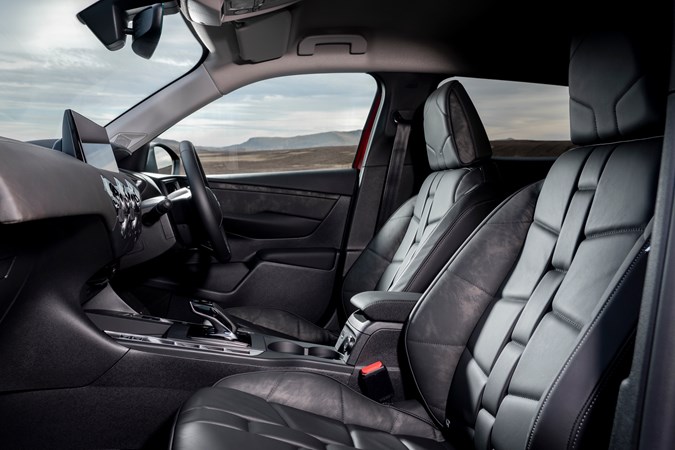
Boot space is towards the bottom of the class, too. You get 350 litres with the rear seats in place and 1,050 litres with the bench folded flat. That means it’s a whopping 125 litres smaller than the Kia Niro EV and 120 litres smaller than the bargain-basement MG ZS EV.
Perhaps most importantly, the DS 3 E-Tense’s boot is 55 litres behind its biggest Stellantis sibling, the Peugeot e-2008, which once again drags the point of its existence into question. In the interest of fairness, though, the DS 3 E-Tense’s boot 40 litres larger than the Vauxhall Mokka Electric’s
Comfort
While the seats themselves are comfortable, their positioning isn’t ideal. The pedals aren’t directly underneath the steering wheel, the centre console juts out too far in the footwell and the seats are mounted higher up than they are in the petrol model because of the battery pack.
This means the driver sits slightly side saddle, with their knee rammed into the unforgiving plastic on the centre console (which will give you a dead leg after about 20 miles). And even with the seat in its lowest position, headroom is tight if you’re tall. What’s more, that plush leather upholstery is quite slippery, so you’ll be constantly sliding down in your seat unless you brace your leg against the firewall.
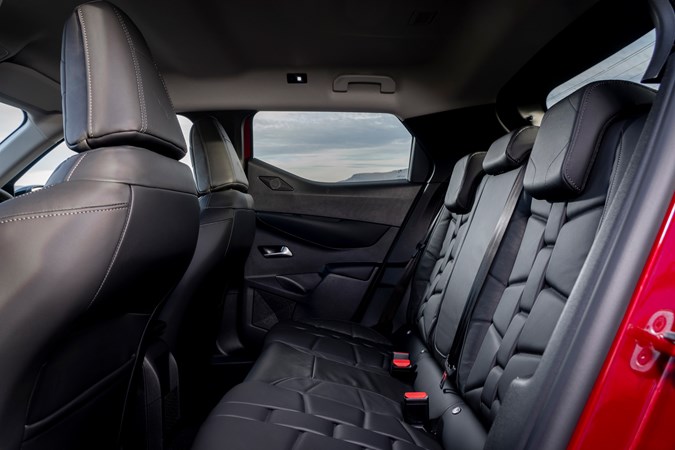
Space in the back is tight, with limited knee room and headroom. To sit up straight, our six-foot tester had to wedge his head into the roof lining – and slouching down in the seat didn’t help because he just ended up forcing his knees into the seat ahead.
Safety
Euro NCAP hasn’t yet crash-tested the facelifted DS 3 E-Tense, but the old DS 3 Crossback achieved a four-star rating when it was assessed in 2019. It’s also worth mentioning that this score was for the cheapest model – if you specify DS’s optional Advanced Safety pack (which adds extras like a cyclist detection system and blind-spot monitoring) the car’s score jumps up to five stars.
These scores look great, but Euro NCAP has restructured its test protocols since 2019, with tougher tests that make it more difficult for cars to achieve five-star ratings. We’re not suggesting the DS 3 E-Tense is an unsafe car, but new five-star electric SUVs crashed under Euro NCAP’s updated tests (like the Kia Niro EV and Smart #1) might fare better in an accident.
What’s it like to drive?
Not bad, but there are better options out there. We’ll start with the powertrain because that’s the best bit (and the biggest change for the facelift). It has a 54kWh battery pack mounted under the floor and a 155hp electric motor bolted to the front axle. The motor has an extra 19hp over the pre-facelift DS 3 but, because it’s a little heavier, it’s ever-so-slightly slower from 0–62mph, taking nine seconds rather than 8.7 seconds. You can’t tell the difference, though.
Like most electric cars, there’s a very satisfying shove when you floor the throttle from rest, with performance tailing off above 50mph. That makes the DS 3 E-Tense very well suited to city driving – you can easily beat boy racers in the traffic light grand prix if the mood takes you.
The DS puts its power down well, too. Unlike cheaper electric cars, such as the MG 4 and Ora Funky Cat, the E-Tense’s platform can manage the motor’s torque using good-old-fashioned mechanical grip, which means the traction control system rarely needs to step in to stop the wheels spinning.

The DS 3 E-Tense’s ride and handling is more of a mixed bag. The EV’s suspension is firmer than the petrol-powered DS 3’s, which it needs to be to control the added weight of the battery pack. But, if you spec it wrong, this change can have a huge impact on the EV’s refinement.
Our range-topping Opera test car came with huge 18-inch alloy wheels wrapped in skinny tyres. At low speeds, they transmitted the sound of every imperfection through the hub, past the firm suspension and into the cabin, which somewhat spoils the ambience of an otherwise silent EV. We’ve also tested a base-spec model, which is an improvement but is still not what you’d call quiet.
The E-Tense also doesn’t tread as lightly as the petrol car, which doesn’t help matters. At a minimum, its battery adds 345kg to the standard DS 3’s kerb weight – and that extra bulk pushes the car into sudden bumps with greater force, transmitting more unwanted sound into the cabin.
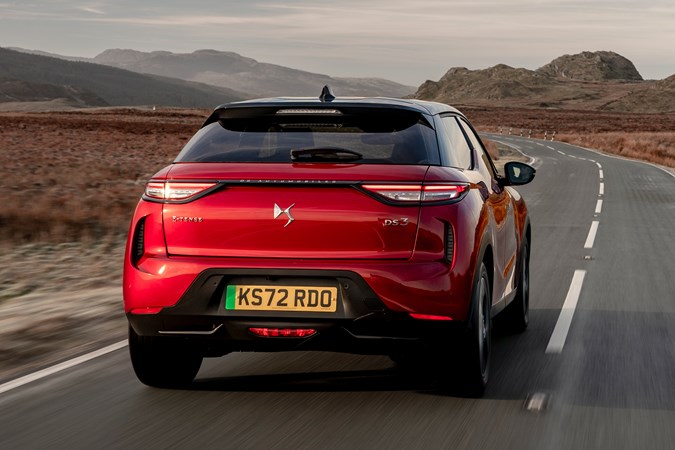
Thankfully, the E-Tense smooths out once you’re on a faster road. The suspension breathes easier over fast expansion joints and potholes; the motor is whisper quiet and DS has done a reasonable job of insulating the cabin from wind noise.
The firm suspension and battery pack also benefits some aspects of the DS 3’s handling. The EV rolls less when cornering quickly and it feels more planted on flat, solid tarmac because the weight of the battery pack underneath the cabin drops the car’s centre of gravity into the road.
But there’s a flipside. The firm, sporty suspension is out of sync with the DS 3’s character. It isn’t a sporty car – and it doesn’t respond well to sporty driving. Take a crest at speed, for example, and the rear of the car will lift off at the peak of the bump because the suspension can’t decompress quickly enough to slow down the movement (unlike a Ford Puma). It fidgets over mid-corner bumps, too.
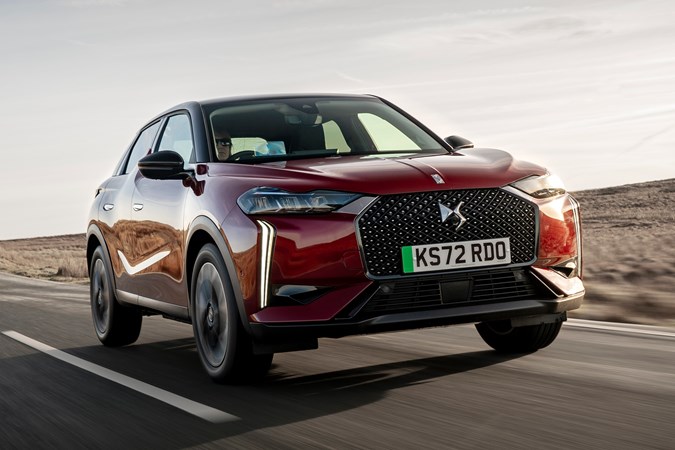
Keen drivers probably won’t make much of the steering system, either. It’s numb but light, which makes it easy to drive around town. Switching to Sport mode doesn’t really improve matters – it just adds weight without any feedback. The accelerator mapping is changed, though, so you get 100% of the motor’s performance sooner in the pedal’s travel.
There’s also a B mode (engaged via the gear selector) that ramps up the regenerative braking, making the car lose more speed when you lift off the accelerator. When this mode is on, the brakes can be grabby and it becomes a bit more difficult to judge how much pressure to apply to the pedal when slowing down. And unlike some rivals, this B mode does not allow for single-pedal driving round town, which some EV converts swear by. Certainly we’d like to see at least a few levels of adjustment.
What models and trims are available?
There’s only one powertrain on offer, but you can choose from four trim-levels. The entry-level Performance Line model starts from just a couple of thousand pounds less than a Tesla Model 3 – but it comes loaded with equipment, such as Alcantara upholstery, keyless start, a digital gauge cluster and a 10.3-inch infotainment system.
The mid-range Performance Line+ variant pushes the price up by a few thousand, but it adds features like connected navigation, voice control, keyless entry, aluminium pedals and 18-inch alloy wheels. Above that there’s the Rivoli which adds another £500 to the price and brings leather upholstery, a unique radiator grille and some extra chrome trim.
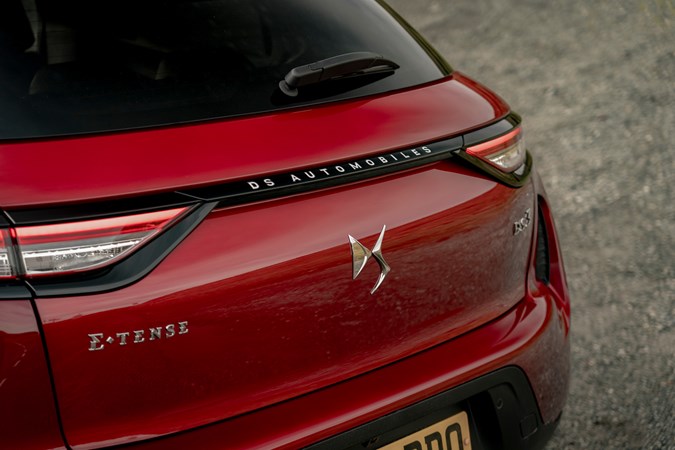
At the top of the range, there’s the DS 3 E-Tense Opera. It costs an awful lot of money considering you can have a fully loaded Kia Niro EV 4 for just £500 more. And the Niro EV is larger, more practical, faster and it can travel further on a single charge. Its build quality is comparable, too – and its infotainment system is arguably better.
Opera models come with lots of equipment, though, including electric, massaging and heated seats, a head-up display, a reversing camera and a wireless smartphone charging pad. You also get DS’s Advanced Safety Pack as standard.
What else should I know?
Range and charging, of course. DS claims the 3 can drive for up to 250 miles, which we’ve found to be a bit of a pipe dream – plan to cover 180 miles if your driving is mixed, or around 220 if you’re doing more miles in town.
This isn’t bad considering this is quite a compact EV, but it’s a wrench when cars of a similar price will provide a repeatable 250+ miles or even over 300 miles of range. All but the entry-level car come equipped with a heat pump, which improves range when using the heater in cold weather.
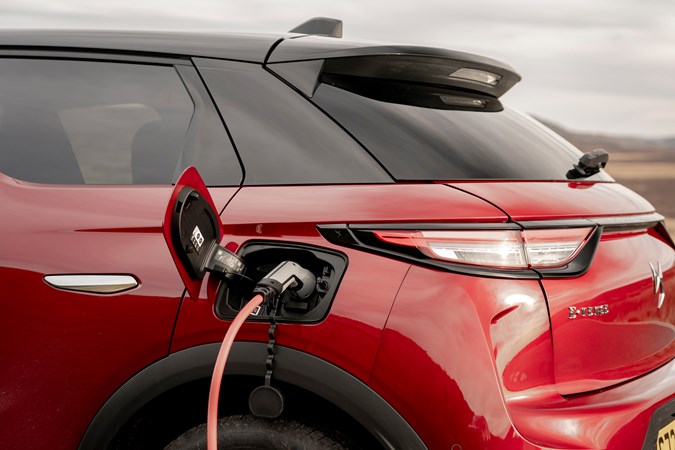
Unlike some other cars of its size, the DS 3 E-Tense comes with support for 100kW charging speeds. That means you top the battery up from 10–80% in just 30 minutes at one of those posh motorway service station charging points. Connect the car to an 11kW wallbox and it’ll charge from empty to full in 5 hours and 45 minutes.
We should also mention DS’s tactic for stealing customers away from the established luxury brands. It’s dedicating a lot of resources to customer service, with some dealers even providing free exclusive tours of the Louvre for buyers.




